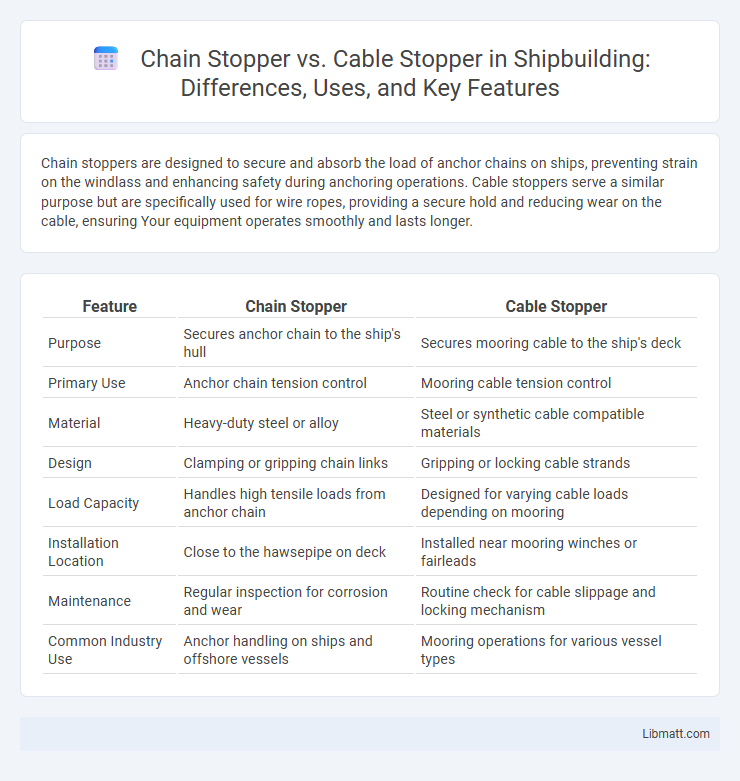Chain stoppers are designed to secure and absorb the load of anchor chains on ships, preventing strain on the windlass and enhancing safety during anchoring operations. Cable stoppers serve a similar purpose but are specifically used for wire ropes, providing a secure hold and reducing wear on the cable, ensuring Your equipment operates smoothly and lasts longer.
Table of Comparison
| Feature | Chain Stopper | Cable Stopper |
|---|---|---|
| Purpose | Secures anchor chain to the ship's hull | Secures mooring cable to the ship's deck |
| Primary Use | Anchor chain tension control | Mooring cable tension control |
| Material | Heavy-duty steel or alloy | Steel or synthetic cable compatible materials |
| Design | Clamping or gripping chain links | Gripping or locking cable strands |
| Load Capacity | Handles high tensile loads from anchor chain | Designed for varying cable loads depending on mooring |
| Installation Location | Close to the hawsepipe on deck | Installed near mooring winches or fairleads |
| Maintenance | Regular inspection for corrosion and wear | Routine check for cable slippage and locking mechanism |
| Common Industry Use | Anchor handling on ships and offshore vessels | Mooring operations for various vessel types |
Introduction to Marine Stoppers
Marine stoppers are essential devices used to secure anchoring systems on vessels, with chain stoppers and cable stoppers being the primary types. Chain stoppers are designed to hold the anchor chain firmly in place, absorbing the load and preventing unwanted movement, making them crucial for heavy-duty anchoring operations. Cable stoppers, on the other hand, are tailored to secure wire ropes or cables, providing effective tension control and reducing wear in mooring applications.
What is a Chain Stopper?
A Chain Stopper is a mechanical device designed to hold the anchor chain securely, reducing strain on the windlass during anchoring operations. It is typically used on ships to lock the anchor chain in place, preventing movement caused by waves or currents. Unlike cable stoppers, which are built for flexible wire cables, chain stoppers are specifically engineered to accommodate the heavy, linked portions of anchor chains.
What is a Cable Stopper?
A cable stopper is a mechanical device designed to secure and hold cables or wires firmly in place, preventing slippage and maintaining tension. Commonly used in marine, construction, and industrial applications, cable stoppers provide reliable anchoring points for stainless steel wire ropes and cables. Your choice between a chain stopper and a cable stopper should consider the type of load and flexibility required, as cable stoppers specifically excel in tension control for wire cable systems.
Key Differences Between Chain and Cable Stoppers
Chain stoppers and cable stoppers serve distinct purposes in maritime mooring systems, with chain stoppers designed to secure heavy anchor chains and cable stoppers tailored for wire ropes or cables. Chain stoppers feature robust, heavy-duty grips and locking mechanisms to withstand significant tension forces, while cable stoppers utilize clamping devices suited for flexible, smaller-diameter cables, ensuring safe load distribution. Understanding these key differences helps you select the appropriate stopper for your vessel's anchoring and mooring needs, optimizing safety and equipment longevity.
Primary Functions of Chain Stoppers
Chain stoppers primarily secure anchor chains to prevent movement and reduce strain on windlasses, ensuring vessel stability during anchoring. They absorb the load from the anchor chain, transferring it safely to the ship's structure and minimizing mechanical wear. Chain stoppers also facilitate quick and secure chain release and retrieval, enhancing operational efficiency during anchoring procedures.
Main Applications for Cable Stoppers
Cable stoppers are primarily used in marine and industrial rigging to secure wire ropes and prevent slippage, making them essential for lifting, towing, and anchoring applications. Unlike chain stoppers that are designed to hold anchor chains and absorb shock loads, cable stoppers provide precise tension control for cables in crane operations, suspension bridges, and elevator systems. Their reliability in maintaining cable integrity under dynamic loads makes them a critical component in construction, offshore drilling, and heavy machinery industries.
Material and Design Variations
Chain stoppers are typically constructed from heavy-duty steel or alloy materials designed to withstand high tensile loads and impact forces in marine applications. Cable stoppers often utilize galvanized steel or stainless steel with flexible design elements to accommodate cable movement and reduce wear. Variations in design include robust chain stopper jaws or locking mechanisms for secure anchoring, versus cable stoppers featuring adjustable clamps or gripping plates optimized for wire rope diameters.
Installation Procedures Compared
Chain stoppers install by securing the anchor chain to the vessel's hull using heavy-duty bolts and welds, ensuring the chain's tension is maintained during anchoring. Cable stoppers attach the wire rope via a clamping mechanism or wedge socket, often requiring precise alignment and tensioning to prevent slippage under load. Both systems demand careful installation to match the vessel's specifications, but chain stoppers generally involve more permanent fitting, whereas cable stoppers allow for quicker adjustments and replacements.
Maintenance Considerations
Chain stoppers require regular lubrication and inspection to prevent corrosion and wear on the pins and links, ensuring smooth operation and longevity. Cable stoppers demand frequent checks for fraying, tension consistency, and securing hardware integrity to avoid abrupt failures under load. Both types benefit from routine cleaning and prompt replacement of damaged components to maintain optimal performance and safety.
Choosing Between Chain and Cable Stoppers
Choosing between chain stoppers and cable stoppers depends on your vessel's anchor system and load requirements. Chain stoppers provide superior strength and security for heavy anchor chains, making them ideal for larger ships and harsh marine conditions. If your vessel uses a combination of chain and wire rope, cable stoppers offer flexibility while protecting the anchor rode and winch from excessive strain.
Chain stopper vs cable stopper Infographic

 libmatt.com
libmatt.com